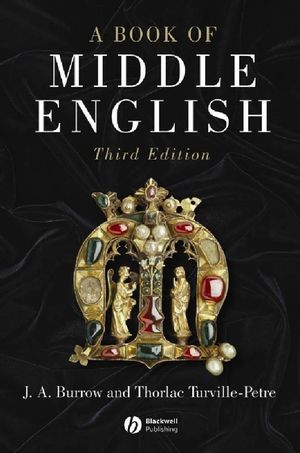A Book of Middle English, 3rd EditionISBN: 978-1-4051-1708-1
Hardcover
436 pages
November 2004, Wiley-Blackwell
 This is a Print-on-Demand title. It will be printed specifically to fill your order. Please allow an additional 10-15 days delivery time. The book is not returnable.
|
||||||
List of Illustrations ix
Preface to the Third Edition xi
Abbreviations xii
Part one
1 Introducing Middle English 3
1.1 The Period 3
1.1.1 From Old to Middle English 3
1.1.2 From Middle to Modern English 4
1.2 Varieties of Middle English 5
1.2.1 Regional Dialects 5
1.2.2 Early and Late Middle English 8
1.2.3 Spelling 8
2 Pronouncing Middle English 9
2.1 Introduction 9
2.2 Vowels 10
2.2.1 The Long Vowels 10
2.2.2 The Short Vowels 11
2.2.3 Unstressed Final -e 11
2.2.4 The Diphthongs 12
2.3 Consonants 12
2.4 Stress 13
3 Vocabulary 14
3.1 Introduction 14
3.2 Scandinavian 14
3.3 English, French and Latin 15
3.4 Latin Loan-Words 17
3.5 French Loan-Words 18
4 Inflexions 19
4.1 Introduction 19
4.1.1 The Inflexional System 19
4.1.2 Loss of Inflexional Endings 19
4.2 Nouns 20
4.2.1 Introduction 20
4.2.2 Noun Inflexions: Early Southern Texts 21
4.2.3 Developments in Noun Inflexions 22
4.2.4 Genitive Singular Without Ending 23
4.2.5 Unchanged Plurals 23
4.2.6 Mutated Plurals 23
4.3 Pronouns and Articles 24
4.3.1 Forms of the Personal Pronouns 24
4.3.2 First and Second Person Pronouns 24
4.3.3 Third Person Pronouns: Masculine and Neuter Singular 25
4.3.4 Third Person Pronouns: Feminine Singular 25
4.3.5 Third Person Pronouns: Plural 26
4.3.6 The Definite Article 26
4.3.7 Demonstratives 27
4.3.8 The Indefinite Article 27
4.4 Adjectives and Adverbs 27
4.4.1 Definite and Indefinite Inflexions 27
4.4.2 Inflexions for Case 28
4.4.3 Comparison of Adjectives 29
4.4.4 Comparison of Adverbs 29
4.5 Verbs 30
4.5.1 Introduction 30
4.5.2 Present Tense 30
4.5.3 Past Tense and Past Participle 32
4.5.4 Past of Weak Verbs 32
4.5.5 The Verbs ‘Have’ and ‘Say’ 33
4.5.6 Past of Strong Verbs 34
4.5.7 Irregular Verbs 35
4.5.8 The Verb ‘To Be’ 36
5 Syntax 38
5.1 Gender 38
5.2 Number 38
5.3 Use of Cases 39
5.3.1 Nominative and Accusative 39
5.3.2 Genitive 39
5.3.3 Dative 40
5.4 Pronouns and Articles 41
5.4.1 Jou and 4e 41
5.4.2 Non-expression of Personal Pronouns 41
5.4.3 Man 42
5.4.4 Self 42
5.4.5 Reflexive Pronouns 42
5.4.6 Relative Pronouns 43
5.4.7 The Articles 44
5.5 Adjectives and Adverbs 44
5.5.1 Position 44
5.5.2 Comparatives and Superlatives 44
5.5.3 Adjectives as Nouns 45
5.6 Verbs 45
5.6.1 Use of Present Tense 45
5.6.2 Use of Past Tense 45
5.6.3 Auxiliaries of the Past 46
5.6.4 Auxiliaries of the Future: shall and will 46
5.6.5 The Infinitive 47
5.6.6 The Subjunctive 48
5.6.7 The Imperative 50
5.6.8 Impersonal Verbs 50
5.6.9 Verbs of Motion 51
5.6.10 The Passive 51
5.7 Negation 52
5.8 Questions 52
5.9 Word-Order 53
5.9.1 Inversion 53
5.9.2 The Object 54
5.9.3 Prepositions 54
5.9.4 Relative Clauses 54
5.9.5 Adverbial Phrases 54
5.9.6 Verb in Final Position 55
5.10 Recapitulation and Anticipation 55
6 Metre 56
6.1 Introduction 56
6.2 Rhymed Verse 56
6.3 Alliterative Verse 59
6.4 La3amon’s Brut 61
7 From Manuscript to Printed Text 62
8 Select Bibliography 65
8.1 Bibliographies and Indexes 65
8.2 Language Studies 65
8.3 General Studies of the Literature 67
8.4 Studies of Particular Genres 69
8.5 Historical and Social Studies 70
Part two: prose and verse texts
Note on Treatment of Texts 74
1 The Peterborough Chronicle 1137 75
2 The Owl and the Nightingale 81
3 La3amon: Brut 96
4 Ancrene Wisse 106
5 Sir Orfeo 112
6 The Cloud of Unknowing 132
7 William Langland: Piers Plowman 141
8 Patience 162
9 Sir Gawain and the Green Knight 182
10 Pearl 202
11 St Erkenwald 221
12 John Trevisa: Dialogue between a Lord and a Clerk 235
13 John Gower: Confessio Amantis 243
14 Lyrics 255
15 The York Play of the Crucifixion 272
16 Geoffrey Chaucer: The Parliament of Fowls 283
17 Geoffrey Chaucer: Troilus and Criseyde 309
18 Geoffrey Chaucer: The Canterbury Tales 327
18a The Reeve’s Tale 328
18b The Prioress’s Tale 346
Textual Notes 356
Glossary 363



